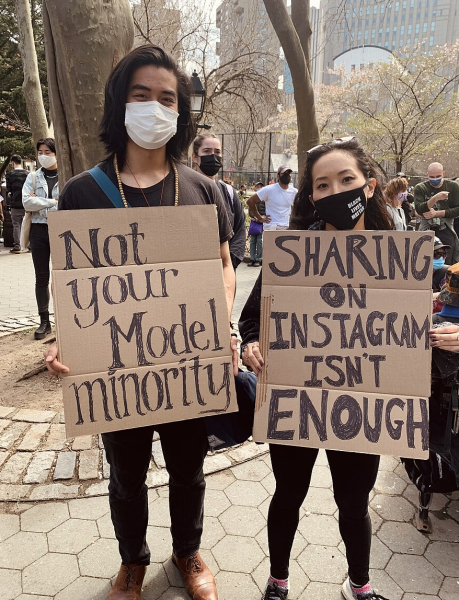Cultural appropriation vs. cultural appreciation
What is the dividing line between appropriating and appreciating another culture?
Cultural appropriation is a constant issue for indigenous groups, particularly around Halloween, as many cultural and traditional garbs have become costumes.
April 20, 2022
The inappropriate adoption of components of one culture or identity by people of another community is known as cultural appropriation. When individuals of a more “dominant” culture steal ideas, trends or concepts from a minority culture, it can be extremely controversial. On the other hand, cultural appreciation is when someone wants to know more about a culture so that they are able to change their perspective on other cultures and races.
Cultural appropriation has many forms. One example of this would be during music festivals. People will often wear traditional outfits from a culture that is not theirs.
Another example would be in 2020 when Parisian fashion designer Isabel Marant was accused of appropriating Mexican heritage by the Mexican Cultural Minister Alejandra Frausto Guerrero. Guerro sent Marant a letter regarding her new collection and using design “celebrating” Mexican culture. Marrant later apologized, but this is sadly not the first instance of something like this taking place.
Recently, it was seen in the celebrity world. Singer Adele got herself into controversy after sharing an Instagram picture of her in which she was wearing a traditional African hairstyle while at the Notting Hill Carnival.
The argument between appropriation and appreciation is quite complicated. But the determining aspect of conflict is often the point at which appropriation becomes exploitation. Are you respecting a culture, or just taking advantage of it? Of her hairstyle at the Notting Hill Carnival, Adele claims that she “didn’t read the f***ing room,” and that, according to Independent, “she’d felt that Jamaican culture was so ‘entwined’ with that part of London that she should ‘dress to celebrate the Jamaican culture.'” Although her execution may have been misplaced, many point to this as an example of appreciation, not appropriation.
“Full appreciation involves understanding,” says James Young, professor of Philosophy at the University of Victoria of British Columbia in Canada and author of Cultural Appropriation and the Arts. Professor Young’s book points to the complexities of examining cultural appropriation in art, something that many postmodern artists and singers have been accused of.
“Both aesthetic and ethical arguments have been advanced against the practice of cultural appropriation of art,” said Professor Young. “One can argue that artworks that are the product of cultural appropriation are bound to be aesthetic failures. Alternatively one can argue that acts of cultural appropriation are immoral. Aesthetic and moral objections could be combined…Many acts of cultural appropriation are, however, morally unobjectionable and some of them result in artworks of great aesthetic value.”
For example, one will be less likely to misuse something that is considered sacred if one understands it. Permission may be required in some situations. Deference to and respect for the experts in a culture is essential. This involves not presenting oneself as an expert.
— Professor James Young
It’s important to understand why appropriating a culture is an issue for so many communities. If you want to include traditions from other cultures, you need to perpetuate them in the right way. It’s crucial to understand what those aspects are and where they come from. That means doing research.
“If one understands a cultural product, one is unlikely to use it in offensive or otherwise objectionable ways,” said Professor Young. “For example, one will be less likely to misuse something that is considered sacred if one understands it. Permission may be required in some situations. Deference to and respect for the experts in a culture is essential. This involves not presenting oneself as an expert.”
Cultural appropriation is hurtful to those whose culture is stolen, especially given how many minority groups and their cultures have been mistreated throughout history. Black women, for example, are considered one of the most marginalized groups in America and the UK. Their appearance is mocked and disrespected in many different medias. A Black girl in school wearing a hairstyle such as cornrows is mocked and told she isn’t feminine, whereas Kim Kardashian can wear the same exact look and be praised without issue. This is an example of how one group can partake in something and are labeled as cool and fashionable whereas another group would be penalized for doing the same.
Many RV students echo this sentiment.
“First of all, I don’t believe anyone should ‘take part’ in another person’s culture,” said senior Lauren Daw. “You can appreciate a culture from afar, but when you start to partake in it, it becomes appropriation. If someone decides they want to take that risk, they need to do extensive research on that culture, to avoid being offensive.”
Some celebrities and individuals claim that they have a “pass” when they offend other races or cultures and point to the work they do or support they give marginalized communities.
No one should get a pass, ever. If a person of color gives their friend a ‘pass’ to say a slur, they are just as bad as the people who use it with harmful intent.
— RV senior Lauren Daw
“No one should get a pass, ever,” said Daw. “If a person of color gives their friend a ‘pass’ to say a slur, they are just as bad as the people who use it with harmful intent.”
Sharing and being a part of other cultures is a healthy way for people in society to coexist and understand each other. It is only when we do it without respect for the cultural contributions that marginalized groups continue to offer, or we don’t bother to understand the issues that they face, that a simple act of appreciation will turn into application. It is time that we start working on dismissing these instances and celebrating others and where they come from.












